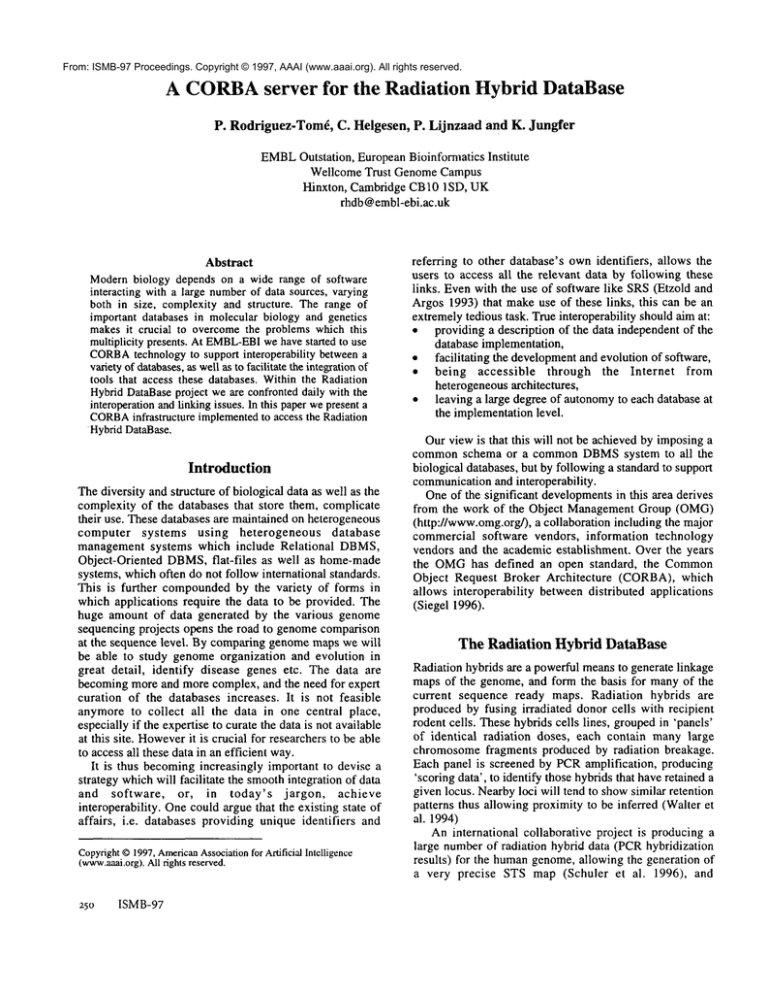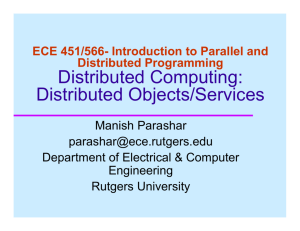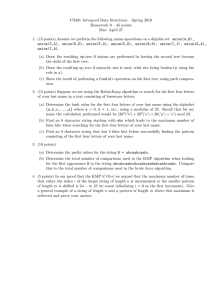
From: ISMB-97 Proceedings. Copyright © 1997, AAAI (www.aaai.org). All rights reserved.
A CORBA
server for the Radiation Hybrid DataBase
P. Rodriguez-Tomf, C. Helgesen, P. Lijnzaad and K. Jungfer
EMBL
Outstation, European Bioinformatics Institute
Wellcome Trust GenomeCampus
Hinxton, Cambridge CB101SD, UK
rhdb@embl-ebi.ac.uk
Abstract
Modernbiology depends on a wide range of software
interacting with a large numberof data sources, varying
both in size, complexity and structure. The range of
important databases in molecular biology and genetics
makes it crucial to overcomethe problems which this
multiplicity presents. At EMBL-EBI
wehave started to use
CORBA
technologyto support interoperability betweena
varietyof databases,as wellas to facilitate the integrationof
tools that access these databases. Withinthe Radiation
HybridDataBaseproject weare confronteddaily with the
interoperationand linking issues. In this paperwepresenta
CORBA
infrastructure implemented
to access the Radiation
Hybrid DataBase.
Introduction
Thediversity and structure of biological data as well as the
complexity of the databases that store them, complicate
their use. These databases are maintained on heterogeneous
computer systems using heterogeneous
database
management systems which include Relational DBMS,
Object-Oriented DBMS,flat-files
as well as home-made
systems, which often do not follow international standards.
This is further compoundedby the variety of forms in
which applications require the data to be provided. The
huge amount of data generated by the various genome
sequencing projects opens the road to genomecomparison
at the sequence level. By comparing genomemapswe will
be able to study genome organization and evolution in
great detail, identify disease genes etc. The data are
becomingmore and more complex, and the need for expert
curation of the databases increases. It is not feasible
anymore to collect all the data in one central place,
especially if the expertise to curate the data is not available
at this site. However
it is crucial for researchers to be able
to access all these data in an efficient way.
It is thus becomingincreasingly important to devise a
strategy whichwill facilitate the smoothintegration of data
and software,
or, in today’s jargon,
achieve
interoperability. Onecould argue that the existing state of
affairs, i.e. databases providing unique identifiers and
Copyright © 1997, AmericanAssociation for Artificial Intelligence
(www.aaai.org).All rights reserved.
250
ISMB-97
referring to other database’s ownidentifiers, allows the
users to access all the relevant data by following these
links. Even with the use of software like SRS(Etzold and
Argos 1993) that makeuse of these links, this can be an
extremelytedious task. Trueinteroperability should aimat:
¯ providing a description of the data independent of the
database implementation,
¯ facilitating the developmentand evolution of software,
¯ being accessible
through the Internet
from
heterogeneousarchitectures,
¯ leaving a large degree of autonomyto each database at
the implementationlevel.
Our view is that this will not be achieved by imposinga
commonschema or a commonDBMSsystem to all the
biological databases, but by followinga standard to support
communicationand interoperability.
Oneof the significant developmentsin this area derives
from the work of the Object ManagementGroup (OMG)
(http://www.omg.org/), a collaboration including the major
commercial software vendors, information technology
vendors and the academic establishment. Over the years
the OMGhas defined an open standard, the Common
Object Request Broker Architecture (CORBA), which
allows interoperability between distributed applications
(Siegel 1996).
The Radiation Hybrid DataBase
Radiation hybrids are a powerful meansto generate linkage
maps of the genome, and form the basis for manyof the
current sequence ready maps. Radiation hybrids are
produced by fusing irradiated donor cells with recipient
rodent cells. Thesehybrids cells lines, groupedin ’panels’
of identical radiation doses, each contain manylarge
chromosomefragments produced by radiation breakage.
Each panel is screened by PCRamplification, producing
’scoring data’, to identify those hybrids that haveretained a
given locus. Nearbyloci will tend to showsimilar retention
patterns thus allowing proximity to be inferred (Walter et
al. 1994)
Aninternational collaborative project is producing a
large numberof radiation hybrid data (PCRhybridization
results) for the humangenome,allowing the generation of
a very precise STS map (Schuler et al. 1996), and
integrating
human eDNAwith meiotically
ordered
polymorphic markers. These maps are indispensable in
positional
cloning of candidate genes to study
multifactorial diseases.
The DataBase
Since July 1995, the EBI has maintained
RHdb
(Rodriguez-Tom6and Lijnzaad 1997) a public database for
radiation hybrid data (http://www.embl-ebi.ac.uk/RHdb).
The database contains both the raw scoring data on
radiation hybrid panels as well as resulting maps. All
entries are systematically cross-referenced to other
databases whenappropriate.
Data is submitted in a specific format, and WWW
based
tools allow the user to access the data via Internet. The
traditional ’fiat-file’ format is used to periodically produce
a complete human-readable dumpthe database. The flatfiles are also indexed using the SRSsystem to provide
query access.
Our first objective was to generate a data model
independent of the actual database implementation. For
that we have used the Object Modeling Technique (OMT)
(Rumbaughet al. 1991) to produce a data model that
reflects our biological understandingof these data.
This data model can be mapped to different DBMSs,
both relational and object oriented ones. Wehave mapped
TM,
our object modelto a relational database using Oracle
which is the RDBMS
used at the EBI.
Support of user needs
With the present implementation, users cannot directly
access the database and build their ownqueries. It does not
support complexqueries or batch processing. Wecould say
that in this form, the database does not meet the full needs
of the user community:
1. provide a set of standard interfaces that permit the easy
retrieval of answers to common
questions,
2. support for extracting large amounts of data for
specialised mappingsoftware,
3. support for complexad hoc queries,
4. allow the client to run on the platform of choice for the
user,
5. ability to respond to the changing needs of the
community.
CORBAand distributed
objects
CORBA,the CommonObject Broker Architecture,
develops on the notion that in order to facilitate
interoperability,
it is necessary to make as many
implementation details (location, network protocols,
operating system, implementationlanguage) as transparent
as possible. This goal is achieved by a strict separation of
interface and implementation which allows the developer
to concentrate on the functionality of an application.
Servers are represented in CORBA
by objects whose
interface is specified by using the Interface Definition
Language(IDL). The services that can be delivered to
client by the server are described in the interface. An
Object Request Broker (ORB) serving as a central
mediator, relays the requests from client to server, and the
result back to the client. The interface written in IDLis
compiled into language specific code (e.g. C, C++,
SmallTalk, Java) at either end of the ORBinto an interface
stub at the client end and an interface skeleton at the server
end. It enables the developmentof distributed objects :
objects that are resident somewhere
on a network.
To be CORBA-compliant,a vendor must implement the
CORBA
core: the Object Model, the Architecture, the IDL
syntax and semantics, the ORBand at least one target
language mapping. In addition the vendor is free to
implementa numberof services that will follow separate
compliance points.
The ORBstores the IDLdefinition of each object in the
Interface Repository. The ORB and the interface
definitions makeclients and servers independent of each
other and allow to combinedistributed objects in a flexible
manner.
Every CORBA
object has to be registered with the ORB.
After registration, the ORBknows what operations and
object supports and howto access it. A client can then
access a CORBA
object with no prior knowledge of its
implementation, by obtaining a reference to this object
from the ORB,thus giving the basis for interoperability.
A CORBAApplication
As a test case we have applied the CORBA
technology to
support external access to the Radiation Hybrid Database.
This has proven valuable experience for subsequently
building CORBA
servers for the other databases at EBI.
The Interface Definition
Wecan define the main object in the database as the
scoring results of a specific PCRhybridization on a given
panel using a specific STS (or marker)for which the
primer sequences, and type are given. This object is named
an experimentor assay, and is given a unique identifier (id)
in the database. STSsare the skeleton of the physical maps,
genetic maps and RH maps, shared by all genomic
databases. They are of interest to any researcher working
on a particular genomicregion.
The second most important objects are the resulting
maps. As a first step we have only implementedthese two
objects in the interface definition.
In this server implementation the data is represented by
two different components:
1. Assay and AssayExtent (a collection of database
objects of the type Assay)
2. Map and MapManager.
The structure and services of the assay Extent: The
AssayExtent is represented by a single CORBA
object
Rodriguez-Tom6
251
which- given a specific id - returns a structure containing
the experimentaldata:
¯ the panel and score vector,
¯ the primer sequences,
¯ the type of Marker,
¯ the chromosome
localisation,
¯ the cross-references to other databases.
The full IDLfor the AssayExtentis shownbelow.
module RH {
struct Assay {
string id;
string chromos ome;
string panel ;
string score;
string pr imer_a;
string primer_m;
string crossrefs;
string types;
typedef sequence<Map> Maps ;
interface MapManager {
Map get(in string mapid);
Maps getAll ()
Map find(in string id);
};
typedef sequence<boolean> Bools;
interface QueryEvaluator {
Bools eval(in Map map, in string
query)
3;
};
The server implementation
Themainsteps of the server implementationandexecution
are :
1.
);
interface AssayExtent (
typede f sequence<string> IDs ;
typedef sequence<string> Scores ;
typedef sequence<string> Crossrefs ;
typedef sequence<string> Types;
boolean exists(in string id)
Assay get (in string id);
Scores getScores(in IDs ids);
Crossrefs getCrossrefs(in IDs ids);
Types getTypes ( in IDs ids);
The structure and services of the Mapobject: The maps
are, in contrast to the assays, representedby individual
CORBA
objects (see table below). A client can retrieve
references to the mapsfrom the mapmanager. Having a
reference to a map, the client will communicate
directly
with the mapobject, bypassingthe manager.
struct Marker {
string id;
float pos ;
boolean fw;
};
typedef sequence<Marker> Markers;
interface Map (
string id()
string chromosome ()
long size();
float top()
float bottom()
float pos (in string id)
Markers getAllMarkers( )
string first ()
string prey(in string id);
string next(in string id)
stringlast ()
);
252
ISMB-97
2.
3.
4.
Initialise the ORB
CORBA.ORBorb = CORBA.ORB.initO;
CORBA.BOA
boa = orb.BOA_initO;
Instantiatethe distributedobjects(here the
MapManager)
MapManager m = new
MapManager("EBIMapManager");
Register the distributed objects with the ORB
boa. obj_is_ready(
m)
Register the server program
andenter the event loop,
waitingfor client requests
boa. impl_is readyO;
The implementationalso includes the implementationof
the methodsas database queries. The code for the server
has been written and compiled on a SunTM workstation
using the Visibroker TM environment from Visigenic
(http://www.visigenic.com/).
Twodifferent implementationsof the server have been
developed, using the JavaTM or C++languages(Jungfer et
al. forthcoming),respectively.
A Java server
TM compiler generates a skeleton, used to
The IDL-to-Java
implementthe server side. The developer has to provide
the code to access the database.At the time of this workwe
did not haveany JavaTM interface to the OracleTM database.
Weaccessed it through OraPerl5scripts called from the
JavaTM code.
A C++ server
The same IDL is now compiled using the IDL-to-C++
compiler. Ouraim in this case is to directly access the
relational database. The RDBMS
we use, OracleTM, does
not yet provide a mappingbetween CORBA
Objects or
C++classes and the relational schema.
Wehave used Persistence TM (from Persistence Inc.,
http://www.persistence.com)to mapthe C++classes of our
skeleton to the relational schema.PersistenceTM generates
C++ classes and methods reflecting the tables and
relationships in the relational schemaas well as standard
methodsto access the relational tables : insert, delete,
select, update. Onlythe moredomainspecific queries need
to be implemented.The PersistenceTMgenerated classes are
then used to implement the C++ classes and methods
defined in the IDLto C++mapping(Fig. 1).
,
IDL objects
mapped to C++
classes
contained by the database, and extract information
concerningmarkers included in specific areas of a map.
The Javaa~ client currently displays six maps side by
side. Clicking on a map position will retrieve the
corresponding information by accessing the AssayExtent
object. The user can highlight all markers on the maps
whichcorrespondto a specific type, or satisfy an arbitrary
score vector specification. This query is resolved by using
the query evaluator component which calculates the
markers to be highlighted using both the AssayExtent and
Mapobjects.
This mapviewer is a Javaru applet that can be accessed
with a JavarM compatible WWW
browser.
Conclusion
Persistence
b C++classes
mapped to
Relational tables
Fig. 1 : The C++server implementation
CORBA
is already an industry standard. Application of
this standard to the EBIdatabases and services will provide
us with a very flexible and dynamicapproach that will be
able to reflect our understanding of biology, and the
structure of biological information as it evolves. Wehave
initiated a project involving specialist databases in Europe
that have a long-term collaboration with the EBIto include
them in the CORBA
approach. This will initially allow a
better exchange of data between the EBI and its
collaborators, and subsequently offer access to these
databases to the research community.
Client implementation:
References
On the client side, the IDL is compiled to generate the
stubs. All the methods for querying the database being
implementedon the server side, the developer of the client
need only to write the application specific routines. The
client programneeds to connect to the ORB,get the object
references and invoke the methodsapplied to the objects :
1. Initialise ORB
ORBA.ORB
orb = CORBA.ORB.init(this);
2. Get object reference to map manager
RH.MapManager mm =
RH.MapManager__var.bitut("EBIMapManager");
3. Invoke methods as they were specified in the IDL
definition of the map manager. Here we ask the
question: "Get object reference to the mapwith the id
’FWl’"
Map map = mm.get("FWl’9;
Etzold, T. and Argos, P. 1993. SRS- an indexing and
retrieval tool for fiat file data libraries. Comput.Appl.
Biosci. 9:49-57.
Client examples
As an example of using the server, we have implemented
different clients in JavaxM. The following client was
developed using Visibroker. More information can be
found at http://v,~vw.ebi.ac.uk/RHdb/RHdb_corba.html.
Siegel, J., 1996. CORBA,Fundamentals and Programming. Wiley ComputerPublishing Group.
Walter, M.A., Spi!let, D.J., Thomas,P., Weissenbach, J.
and Goodefellow, P.N. 1994. A method for constructing
radiation hybrid maps of whole genomes. Nature Genet.,
7:22-28.
Schuler, G.D. et al., 1996. A Gene Map of the Human
GenomeScience, 274(5287):540-546.
Rodriguez-Tom&
P. and Lijnzaad, P. 1997. The Radiation
Hybrid DataBase. Nucleic AcidRes, 25(1)81-84.
Rumbaugh,J. et al, 1991. Object Oriented modeling and
Design, Prentice Hall.
Jungfer, K. et al, Forthcoming.
The Map viewer applet
The purpose of this application is to visualize the maps
Rodriguez-Tom6
253







